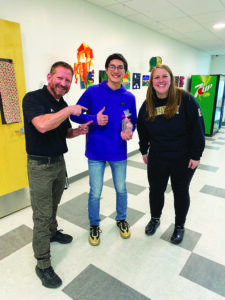Superintendent, board tackle budget shortfall
by John Dowd
Like a lot of schools, post Covid-19, Stevensville is struggling with reductions in their budget. According to Stevensville Schools Superintendent Dave Thennis, the main struggle for many schools comes from the phasing out of pandemic funds. During the outbreak, the federal government issued extra financial assistance to schools nationwide through the Elementary and Secondary School Emergency Relief Funds (ESSER). These came through several different bills, and grants. The funding was intended to help schools continue to meet the needs of students through remote learning and other technologies.
The funding was set to expire in September of 2022, and now that a new school year is on the horizon, many schools across the country may have to cut back, just as Stevensville may have to. As Thennis explained, Stevensville Schools are currently down around $380,000 for the elementary school and $330,000 for the high school, with the majority of this lack of subsidization due to the disappearing ESSER funds. “Unfortunately, district budgets are primarily about people,” added the superintendent. According to Thennis, the most effective way for Stevensville to cut its budget is through a reduction in staffing.
Thennis hopes that much of the staffing reductions will be resolved through retirement and resignations. Past that, to make those decisions, Thennis said it will come down to “weighing if you can encumber that person’s duties and still provide students what they need.”
The other aspect challenging the budget, said Thennis, is the recent high absence rate among students. This is leading to reductions due to the enrollment average, which determines the funding schools receive. Each school determines their annual ANB, or Average Number Belonging, from their attendance rate. This number is used by a school to collect funding from federal and state agencies. Thennis explained that another challenge resulting from the pandemic for many schools is attendance. According to him, since schools were more flexible on attendance during the pandemic, many students have gotten used to this laissez-faire approach to attendance.
Thennis says this is going to require some “habit adjustment” from school systems and teachers. “It is definitely something we are working hard to fix.” He explained that the lack of attendance is more than just a problem for school funding. “School is hard enough, and when you’re missing bits and pieces it becomes more challenging,” said Thennis. “Gaps in understanding of a topic contributes to being overwhelmed and can lead to dropouts,” bringing the situation full circle back to students not wanting to attend. To combat these issues, Thennis said that Principal Eric Larson and Assistant Principal Angie Armour, at Stevensville High School, have a plan.

Attendance problem requires creative solutions
With challenges facing the Stevensville Schools from the lack of attendance, the staff at the high school have some ideas on how to change things. According to Angie Armour, Stevensville High School Assistant Principal, 72% of students were chronically absent last school year. This means that they had missed more than 10% of the school days of year. So far this year, 58% of the students have been chronically absent. “I think during Covid we were in unprecedented times, so we tried to be understanding,” said Armour. However, “expectations are now having to be retaught.”
According to High School Principal Eric Larson, “it got to be a little bit of a norm,” therefore, “reengagement has been tough.” During the pandemic, “it wasn’t a big deal to come in late, miss days, etc.” said Larson. However, with the pandemic over, Stevensville is now trying to get their students back on track. To do this, the school is implementing what they are calling their “Attendance Matters” campaign.
The first step of this campaign is, according to Larson, “to ensure that our school is that engaging and positive environment.” In other words, “ensuring that relationship dynamic.” Throughout the year the school is also hosting activities like food drives and group events to create a collective team feeling, said Larson.
The other aspect is what Armour calls a three-pronged effort. This will see engagement with the students, staff and community of parents, to impress the importance of attendance. One activity she believes went over well was the Attendance Matters Video Competition. During this, students were encouraged to team up and make videos to explain the importance of coming to school every day. These videos were judged by local businesses and prizes were given out. Then all the videos were watched in classrooms.
Another effort has been sending out information home to parents. A letter was sent that talked about the campaign. The letter also asked about barriers faced by families in getting students to school so Stevensville High could address those challenges. For the month of March, the school is hosting a “March Madness” event, in which they are trying to get local police and firefighters involved. This will include a weekly drawing for the best attendance, which will lead to prizes.
Businesses who have donated and supported this campaign so far are Romeo’s Italian Kitchen, Peacock Floral, Stevensville State Farm Insurance, Stevensville Parent Teacher Club, Stevensville Booster Club, Kodiak Jax, Super 1 Foods, Valley Drug & Variety, Trapper Peak Coffee and Cenex.
According to Larson, a popular voted prize has been a front parking spot. “We want students to feel like they are part of something bigger than themselves,” said Larson. Classes are also encouraged to have friendly competition between themselves in attendance. For this, another popular prize has been to “pie” the school resource officer.
Armour explained that they want to make school a fun place that students want to be. Another plan is to create systems that carry on to following years, offering more rewards for high student attendance. Hopefully, these systems will promote good attendance year after year.